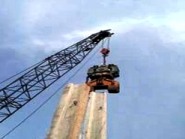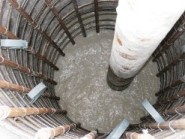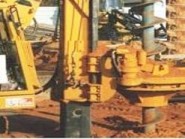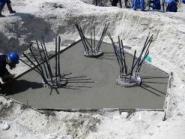|

 Driven
Piles Driven
Piles
Prefabricated steel, wood or
concrete piles are driven into the ground using
impact hammers. Driven piles provide the fastest
deep foundation solution. Driven piles provide the
advantage over drilled shaft piles of higher skin
friction, thus increasing their load-bearing
capacity. They are suitable for most land and
marine applications, and offer a high performance
piling system with up to 1,000 tons/pile design
load capacity.
Steel piles such as sheet and
H-beam piles (soldier piles) to form earth
retention and excavation support walls, are the
most commonly used. Wood and reinforced concrete
are used in other limited conditions.
 Top Top
 Cast
in-Situ Bored Pile Cast
in-Situ Bored Pile
This type of pile installation is
used to replace soil removed by drilling rather
than occupying the space of displaced soil as in
driven piles and thus, it mostly relies on
end-bearing capacity of the earth layer at the
drilled depth.
One method of installation is to
drill a shaft using a continuous auger with a
hollow stem at its center which is later used to
grout the drilled shaft. This method is known as
Continuous Flight Auger.
Another technique is to drill the
shaft, insert the reinforcement steel cage (if
required) and then pour concrete under pressure to
fill the entire shaft space. The shaft is drilled
using an auger in dry land conditions and a
drilling bucket in wet land conditions.
When shaft wall support is required, the
drilling process takes place inside a steel casing
or with the aid of drilling slurry such as
Bentonite.
Steel drill casing is advanced
into the ground using a vibro-hammer; leaving a 1
meter protrusion. After drilling, the steel cage
reinforcement is placed within the borehole using
a crane and concrete is poured in the borehole
under high pressure using a tremie. The temporary
casing is then gradually extracted from the ground
by vibrating, oscillating or rotating and load is
transferred to the formed concrete pile shaft.
In situations where the use of
steel casing is not feasible, a drilling mud such
as bentonite slurry in utilized for drilling
support. A positive head of bentonite suspension
above the water table is maintained during the
drilling process, thus providing continual support
to the borehole walls. Fluid concrete displaces
the clean bentonite which is collected and reused
several times before it is discarded.
 Top Top
 Continuous Flight
Auger (CFA) Piles Continuous Flight
Auger (CFA) Piles
This method combines all major
piling operations in a single process and hence it
provides for a highly productive, cost-effective
solution that facilitates fast, noise and
vibration free piling installation. CFA is
implemented in soft to medium strength rock and in
sand, gravel or slit land with ample adhesion and
end-bearing strength.
A continuous flight auger with a
hollow stem at its center is utilized for the
drilling process. The end of the hollow stem is
sealed with an expendable cap to prevent
contamination. During the drilling process drilled
matter rests at the top of the auger flights
maintaining positive pressure at the shaft walls
and thus providing it with lateral support and
stability. After reaching the desired drilling
depth, concrete is pumped at a controlled rate
through the hollow stem blowing off the expendable
cap. The auger is simultaneously withdrawn at a
rate synchronized with the concrete pumping
process such that the pumped concrete promptly
occupies the displaced volume exerting a positive
pressure which assists in the extraction process
whilst maintaining lateral support to the
surrounding soils. The steel reinforcing cage (if
required) is then immersed into the wet concrete.
Typical CFA applications are for a maximum pile
depth of 12m and 600mm diameter. However, larger
pile dimensions can be achieved.
 Top Top
 Pile Caps
and Capping Beams Pile Caps
and Capping Beams
Pile caps connect groups of piles
to distribute loads over the capped piles. Pile
heads are stripped to expose the steel
reinforcement to be projected into the pile cap.
Steel reinforcement is placed at the desired
location and a large concrete block is formed.
Pile caps can assume a variety of shapes, but they
are mostly rectangular or triangular.
 Top Top
|